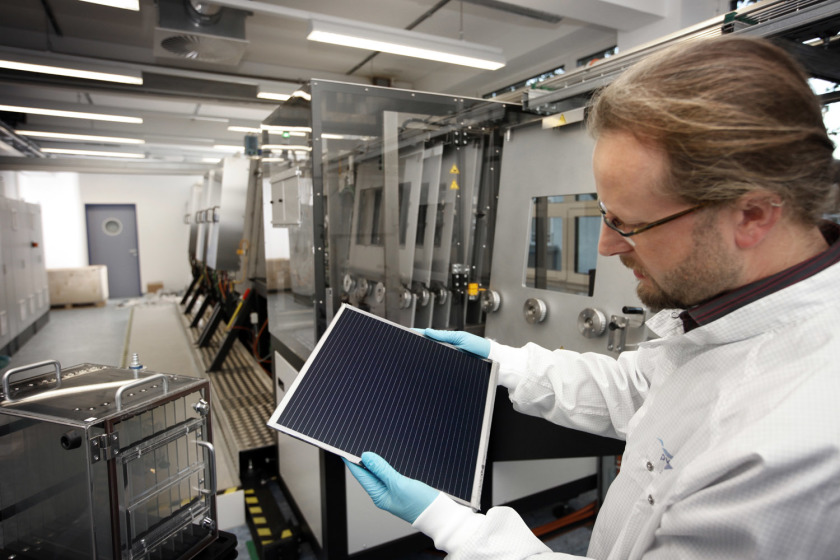Speeding up CIGS solar cell manufacture

The funding will go towards optimising a co-evaporation process at PVcomB used for producing CIGS layers for thin-film solar cells. Photo: HZB

The CIGS thin film photovoltaics can be integrated pleasingly into building architectures. Photo: Manz AG
Speeding up CIGS solar cell manufacture
A project consortium from research and industry involving the Competence Centre for Photovoltaics Berlin (PVcomB) of Helmholtz-Zentrum Berlin has been granted a major third-party-funded project by the Federal Ministry of Economics. The project “speedCIGS” is to be funded with 4.7 million euros over four years, of which 1.7 million goes to HZB. The project partners will use this money to accelerate the manufacturing process for CIGS thin-film solar cells and thus make the technology more attractive to industry.
The speedCIGS project is being carried in cooperation with systems builder Manz AG, the Center for Solar Energy and Hydrogen Research Baden-Württemberg (ZSW), the Universities of Jena and Paderborn, the Max Planck Institute Dresden and the Wilhelm Büchner Hochschule (as project coordinator).
The acquired funding will go towards optimising a co-evaporation process at PVcomB used for producing CIGS layers for thin-film solar cells. CIGS solar cells get their name from their constituent elements Copper, Indium, Gallium and Selenium. The elements are deposited together in a vacuum onto a heated substrate to form a thin layer of the desired compound. The manufacturing process used at PVcomB is already being used industrially, but is still relatively slow. The process is now to be sped up within the speedCIGS project, so that more modules can be produced per unit time for the same investment costs. This would make the production of CIGS solar modules much cheaper, giving the technology a competitive advantage in the currently tense market situation.
Also to be developed at PVcomB is a transparent p-conducting material that will go a long way towards developing high-efficiency tandem solar cells based on CIGS.
Polycrystalline CIGS solar cells already stand out for their high efficiency and high energy yields. Another advantage is the aesthetic appearance of the modules, which integrate pleasingly into building architectures.
(sz/il)
https://www.helmholtz-berlin.de/pubbin/news_seite?nid=14566;sprache=en
- Copy link
-
The twisted nanotubes that tell a story
In collaboration with scientists in Germany, EPFL researchers have demonstrated that the spiral geometry of tiny, twisted magnetic tubes can be leveraged to transmit data based on quasiparticles called magnons, rather than electrons.
-
Bright prospects for tin perovskite solar cells
Perovskite solar cells are widely regarded as the next generation photovoltaic technology. However, they are not yet stable enough in the long term for widespread commercial use. One reason for this is migrating ions, which cause degradation of the semiconducting material over time. A team from HZB and the University of Potsdam has now investigated the ion density in four different, widely used perovskite compounds and discovered significant differences. Tin perovskite semiconductors produced with an alternative solvent had a particular low ion density — only one tenth that of lead perovskite semiconductors. This suggests that tin-based perovskites could be used to make solar cells that are not only really environmentally friendly but also very stable.
-
Synchrotron radiation sources: toolboxes for quantum technologies
Synchrotron radiation sources generate highly brilliant light pulses, ranging from infrared to hard X-rays, which can be used to gain deep insights into complex materials. An international team has now published an overview on synchrotron methods for the further development of quantum materials and technologies in the journal Advanced Functional Materials: Using concrete examples, they show how these unique tools can help to unlock the potential of quantum technologies such as quantum computing, overcome production barriers and pave the way for future breakthroughs.
